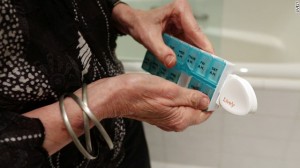
Technology like this pillbox sensor from Lively can help caretakers monitor people with Alzheimer’s and dementia from afar.
Sensors may be the answer to easy and accessible in-home senior care – at least that’s what the elder care tech industry is trying to achieve.
It’s no secret that the American population is greying, and with the continuing aging of the “baby boom” generation, the issue of independence at home has become a high priority. Now, seniors have to opportunity to stay in their own homes safely thanks to sensors.
This from CNN:
SmartThings is a DIY home automation system that connects sensors and smart devices with a wireless hub. In addition to sensors like those in Mary Lou’s home, the system can loop in smart thermostats, smart plugs, door locks and surveillance cameras.
These sensors are catered to seniors who are living independently with Alzheimer’s or some form of dementia. Motion sensors are set in place to alert family caregivers if their loved one has left the home unexpectedly, is experiencing any sleeping or eating issues, or is having any structural issues in the home.
Overall, the sensors are highly customizable and can connect to virtually anything in order to monitor almost every aspect of the person’s life – including the ability to track health behaviors.
From CNN:
Wearable devices can also track health and behaviors, and built-in accelerometers can pick up on physical changes or tell when a wearer has fallen. Tempo is a wristband for seniors that picks up on lapses in routine or changes in gait that might indicate mental or physical deterioration.
While connecting to the home and being able to continually monitor health patterns through wearable technology is a huge advance, many believe it is not enough to replace the personal care provided by families. Though, these new technologies allow seniors to maintain their independence at home for a much longer period of time.
Find out more about sensor technology in the ECS Digital Library.


